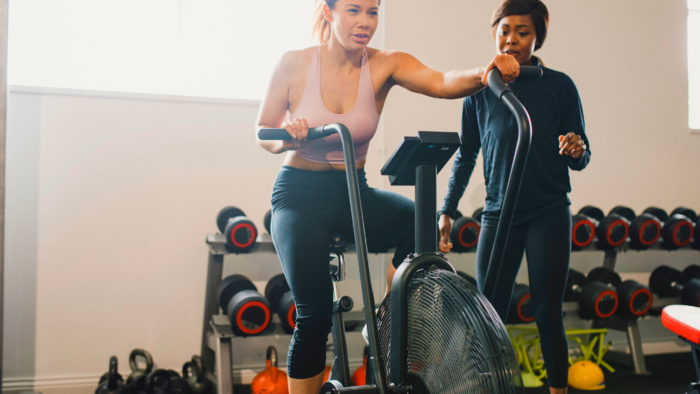Cardio- The Second Foundation of Fat Loss
Scrap everything you’ve heard about fat loss and start with the Foundations!
In the Weight Loss Basics: The 3 Foundations of Fat Loss Series, we explored the best exercise for fat loss: weight training.
Weight training builds muscle, which in turn, increases your metabolic rate.
Having a higher metabolic rate lets you burn more calories throughout the day- without additional exercise!
Here in the part two of the Foundations of Fat Loss series, we cover the other half of the exercise game:
Cardio for Fat Loss
Cardiovascular training is the second foundation of fat loss.
Given that the majority of gyms have an abundance of cardio equipment- treadmills, bikes, Stair Master’s and elliptical machines, cardio is the most popular fat loss exercise.
But here’s the catch- if you truly want to lose fat, it’s not which machine you use, but how you use it.
The number one factor in using cardio for fat loss is intensity.
How To Make Cardio For Effective

Whether you’re sprinting around the park, riding the recumbent bike, or cranking out on the elliptical machine, the amount of fat you lose in in proportion to the intensity you put forth.
Intensity can be increased in various ways, and can be applied to all forms of cardio exercise.
For example, if you are on the recumbent bike, you can increase the level (resistance) you are pushing against. You could also increase the speed at which you decide to pedal.
The same goes for an elliptical machine- you can increase the resistance on the machine, and you can increase the speed with which you perform the movement.
Remember, the harder you push yourself, the more calories you’ll burn in a short amount of time. The more the metabolic demand on your body, the longer you’ll actually burn calories AFTER the workout.
The second factor in making the most of your cardio workout is to change the variables.
For example, in the gym, you can vary the type of cardio machine. (switch up the treadmill for the elliptical or recumbent bike).
If you’re doing cardio outdoors, you can sprint in varying intervals and change distances. You can also change the speed at which you run. You can run on flat surfaces or hills.
Get creative and make it FUN.
The reason you want to change variables in each workout is this; each time your body perform the activity, it gets neural-efficient.
This means your body “remembers” the movement and gets better at doing it. This in turn allows the body to go on auto- pilot, which decreases the number of calories burned.
By combining intensity and uniqueness of movement, the body continues to burn calories; not only when performing the activity, but for hours after.
This is the key post-exercise increase in metabolic rate called “EPOC” or Excess Post- Exercise Oxygen Consumption.
Excess Post- Exercise Oxygen Consumption (EPOC)
One of the best ways to increase EPOC is through interval training. Specifically, alternating a burst of high intensity with a period of low intensity (to allow recover enough for another burst).
EPOC describes the increased calorie burn that comes after the workout.
During the recovery period right after exercise, your body is busy repairing the “damage” done during the workout. It is this “repairing activity” where your body burns a ton of calories.
This is absolute GOLD in terms of fat loss.
Here is a powerful sample program below. (Adjust for your personal conditioning level).
Monday
Elliptical Machine 20 Minutes Total.
2 Minute Warm up-
level 8 at 70 RPM’s
Full Speed:
30 second burst- level 15 at 90 RPM’s
alternate with
2 minutes level 10 at 70 RPM’s
Wednesday
Recumbent Bike 15 Minutes Total
2 Minute Warm Up-
level 8 at 55 RPM’s
Full Speed:
1 minute burst- level 14 at 90 RPM’s
alternate with
2 minutes level 10 @ 70 RPM’s
Saturday
Sprinting at the park or beach 17 minutes total
3 minute jog (loosen up the body, light stretch)
Choose landmarks approximately 30-40 yards apart, depending on your conditioning.
Sprint as an Olympic sprinter would- fluidly and as fast as possible between landmarks. Once you pass your landmark, slow to a light jog for approximately 1 minute and 30 seconds.
Then, perform another identical sprint.
Alternate the sprint and the jog until you’ve completed 6 sprints.
Workout Complete!
Immediately after the workout, you want to feed your body the proper nutrients to assist in the repairing processes, and boost your EPOC as described above.
There is a crucial 2 hour window of opportunity in which the body is like a sponge, absorbing a higher rate of nutrients. We need to take full advantage of this window. (Part 3 of the series)
